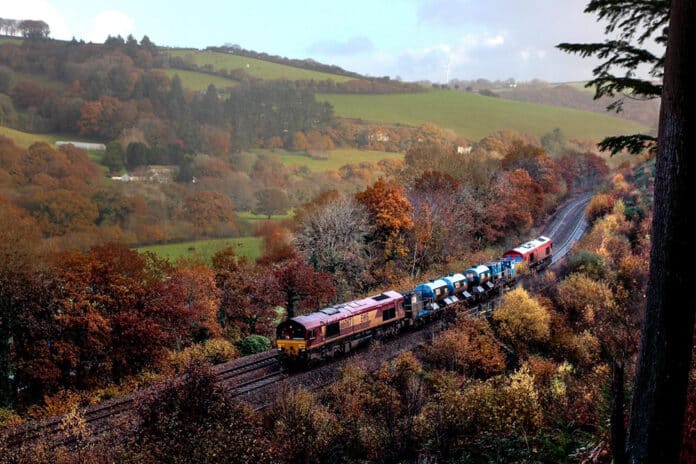A special fleet of ‘leaf-busting’ trains have started blasting leaves off the line to help keep passengers and freight moving across the West Midlands and Chiltern main line and the North West this autumn.
From this week until mid-December, five specialist trains will wash leaf debris from a total of 83,459 miles of track across the West Midlands and Chiltern main line while trees are shedding their leaves.
From this week until 12 December, six specialist trains will wash leaf debris from up to 96,000 miles of track across the North West while trees are shedding their leaves.
Aerial drones are also being used for the first time to check known hotspots where leaf fall can cause the worst disruption.
The seasonal delivery depot at Kings Norton in Birmingham is the nerve centre for keeping tracks in the West Midlands, West Coast main line to Euston and Chiltern main line to Marylebone clear for passengers this autumn.
Three trains known as MPVs (multi-purpose vehicles) and two trains called RHTTs (rail head treatment trains) will operate from the Kings Norton depot.
Network Rail’s seasonal delivery depot at Wigan Springs Branch is the North West’s nerve centre for keeping tracks clear between Crewe and Carlisle this autumn.
Five trains known as MPVs (multi-purpose vehicles) will work from Wigan, while another train known as an RHHT (rail head treatment train) will operate from Carlisle Kingmoor depot in Cumbria.
After railway lines have been cleared with high pressure water jets, the machines then apply rails with a glue-like coating to help passenger and freight train wheels grip the tracks.
Regarded as the railway’s equivalent of black ice on the roads, leaves on the line can create issues when they stick to damp rails and are compressed by moving trains into a thin, black layer which can affect train braking and acceleration.
The build-up of leaf mulch can also make it harder for signallers to detect a train’s location, causing delays.
Martin Colmey, operations director for Network Rail’s Central route, said: “Leaves on the line are a big problem for the railway. It disrupts services and inconveniences passengers and every year, Network Rail and train operators work together to battle against the elements to get passengers and freight to their destinations.
“We are ready to keep people and goods moving across the West Midlands and Chiltern Main line running a safe and reliable service for our customers.”
Last year Network Rail spent £4.7million to keep passengers in the West Midlands and across the Chiltern main line moving during autumn and £5 million on the North West route.
This year, 108 traction gel applicators have been positioned across the Central route and 77 across the North West route. They spray a special sand-like gel onto the rails to help provide extra grip for train wheels.
Specialist teams will be positioned across the region to check that the autumn treatment programme is working effectively and provide additional support where necessary.
Rob Cummings, seasonal improvement manager at Northern, said: “We are working hard as an industry to clear leaves from the line and to keep disruption to a minimum during the autumn period.
“We have introduced special timetables on problematic routes to give our customers a more reliable service and our drivers also have advanced training to help develop techniques which further reduce the impact of slippery rails. We are also helping to develop new innovative technology that will reduce the impact of leaves on the line.”
For more information on how Network Rail deals with leaves on the line visit www.networkrail.co.uk/leaves
*The Grand Railway Collaboration represents train operators across the West Midlands
Photo and video credit: Network Rail







































 0113 2082620
0113 2082620 info@railbusinessdaily.com
info@railbusinessdaily.com 15 Mariner Court, Wakefield WF4 3FL
15 Mariner Court, Wakefield WF4 3FL

